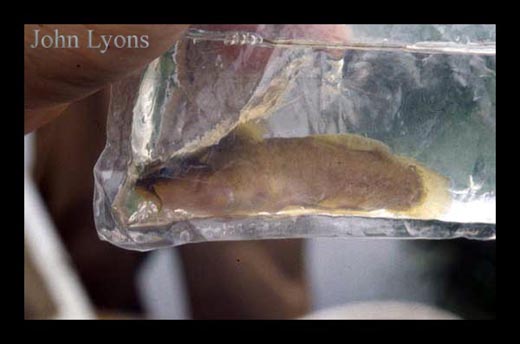Reproduction
Noturus exilis reproduces in the same way as many other fish. They are dioecious, meaning they have two separate sexes. According to Burr (1984), no sexual dimorphism exists in the slender madtom, which means both genders look essentially the same. The only exception to this is a slight size difference with males being a bit larger than the females.
 The
first topic to cover is of course, the actual act of reproduction. Sexual
fertilization occurs externally, with the female laying eggs into the water and
the male then fertilizing them. Reproduction happens seasonally in the summer
months, with the majority of spawning taking place in May and June. It is
thought that this spawning season may be triggered by specific olfactory
signals, however this has never been proven. Females can potentially spawn in
the first summer of their lives, but only if they have grown to a large enough
size. Otherwise, all slender madtom can spawn by the time they've reached two
years of age (Vives, 1987). When a female slender madtom does spawn she can lay
150-200 eggs at a time (Wisconsin Deaprtment of Natural Resources, 2013). The
average nest however doesn't contain that many eggs, suggesting that the slender
madtom is polyandrous. In other words, females will mate multiple times over the
course of the mating season with several different males (Burr and Mayden,
1982).
The
first topic to cover is of course, the actual act of reproduction. Sexual
fertilization occurs externally, with the female laying eggs into the water and
the male then fertilizing them. Reproduction happens seasonally in the summer
months, with the majority of spawning taking place in May and June. It is
thought that this spawning season may be triggered by specific olfactory
signals, however this has never been proven. Females can potentially spawn in
the first summer of their lives, but only if they have grown to a large enough
size. Otherwise, all slender madtom can spawn by the time they've reached two
years of age (Vives, 1987). When a female slender madtom does spawn she can lay
150-200 eggs at a time (Wisconsin Deaprtment of Natural Resources, 2013). The
average nest however doesn't contain that many eggs, suggesting that the slender
madtom is polyandrous. In other words, females will mate multiple times over the
course of the mating season with several different males (Burr and Mayden,
1982).
Nesting is also an important aspect of the slender madtom's reproduction. Noturus exilis pick specific places to lay their eggs. They seem to like nesting in water that is about 20 degrees Celcius and under large flat rocks that offer both water flow and protection for the eggs guarded within. Females have been found to abandon the nest within a day of spawning, leaving the male to guard the eggs and look after the hatchlings. In fact, the size and age of the male guarding a nest has been correlated to the number of eggs found within. Essentially, the more eggs in the nest, the larger the male guarding them will be. Observing these things, Burr (1984) believed the females exhibit sexual selection, preferring to mate with the larger males. He thinks there may be several lines reasoning behind this behavior. The first reason being that because of their larger size the bigger male may be able to secure a better nesting site. The second reason is he believes the larger males may be more likely to stay and protect the nest, while the smaller males may abandon the nesting spot.
Once the eggs have been laid and the nest attended to, it's time for the newly fertilized eggs to develop. Burr (1984) recorded the development of the Noturus flavater, a species of incredibly close relation to Noturus exilis. In his writing Burr comments on how similar the two are in their development, so it safe to say that what applies to the development of one also applies to the other. He observed that embryos of just over 100 hours of age would stick to one another in a type of round glob, but did not stick to any of its surroundings. The embryos at this stage are round and are yellow or orange in color. By 2-3 days after hatching they have developed into mesolarvae which slightly resemble the adult, but with skewed proportions and light patterning begins to appear on the sides and back. They continue to grow and by 10-12 days of age they have become metalarvae. Metalarvae more closely resemble adults in form and the pigment patterning has become darker. It will not become a full adult until at least 24 days after hatching, generally longer.
Now that you've learned about the reproduction and development of the slender madtom, take a look at facts related to its conservation. You may also return to the homepage.